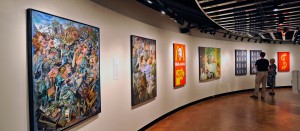
Freedom of speech and expression are believed by many to be among the most important rights of United States citizens. These rights may not be thought about every day, but they would be missed if they were taken away. An interesting issue to consider is the response we might have to such a restriction. Would we concede to the stringent demands placed upon us, or would we fight and continue to express ourselves?
The seventy-six images hanging in the Hillstrom Museum of Art’s exhibit “Forbidden Art: The Post-war Russian Avant-Garde” are by artists who dared to defy the Communist government in Soviet Russia during the early 1900s. While many people were silenced, several daring artists challenged the authorities and produced works that we can look upon and admire, not just for their artistic quality, but also for the freedoms they represent.
It was a bold move; consequences for such violations included censure, loss of employment, declarations of insanity and exile. The fierce passion that these artists had for their work makes their art an inspiration for both art connoisseurs and the general public.
“The works can be appreciated by artists and non-artists alike, on several levels, starting with the pure visual joy or interest they present, and also including the subjects of the individual works and the fascinating context in which they were made, which in my opinion serve to amplify the visual delight and intrigue,” said Don Myers, director of the Hillstrom Museum of Art and professor of art and art history.
In 1917, the Russian Revolution presented individuals with the potential of a utopian society. For artists, this brought the hope that they would be free to create new art that was not required to meet the approval of the Communist regime. This freedom led to an explosion of abstract, formalist art in the following years.
The rise of Joseph Stalin, however, brought this freedom to a halt. Stalin, who declared that art must follow certain guidelines, banned erotic content and art that was critical of the government, among various other constraints.
“It’s inspiring that such fine things were being produced even though officially prohibited, and this demonstrates that, despite how crushing to the human spirit regimes such as the Soviet Union, or for that matter, China, could be, that spirit can sometimes be found shining through in unexpected ways, as in many of these works of art,” Myers said.
Stalin’s death in 1953 brought another surge of hope, and abstract and contemporary art was displayed in Russia from 1956-1961. This bold artwork caused repeated conflicts with the government.
In one extreme case, police bulldozed an exhibit and sprayed the works with fire hoses. Repression continued for years, but underground art expanded, and the artists pushed for freedom and recognition.
Finally, in the late 1980s, Mikhail Gorbechev created policies that allowed for free and energetic expression.
“Forbidden Art: The Post-war Russian Avant-Garde” will be on display through Sunday, Nov. 9. The Hillstrom Museum is open Monday – Friday from 9 a.m. to 4 p.m and Saturday – Sunday from 1 p.m. to 5 p.m. Admission is free and the exhibit is open to the public.